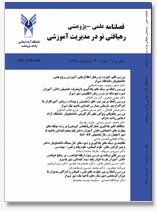واکاوی تاریخچۀ آموزش و توسعه منابع انسانی درایران: از عصر سنت تا دوره ثبات
محورهای موضوعی : آموزش و پرورش
محمد حاجی زاد
1
*
,
سعید صفایی موحد
2
![]()
1 - استادیار، گروه علوم تربیتی، واحد نکا، دانشگاه آزاد اسلامی، نکا، ایران
2 - استادیار شرکت ملی نفت ایران.
کلید واژه: توسعه منابع انسانی, پژوهش تاریخی, عصر سنت, دوره استقرار, دوره ثبات,
چکیده مقاله :
مقدمه و هدف: هدف اصلی این پژوهش بررسی سیر تاریخی آموزش و توسعه منابع انسانی در ایران است. نگارندگان معتقدند این حوزه از فقر آگاهی تاریخی در کشور رنج برده و همین ناآگاهی تاریخی میتواند منجر به دوبارهکاری و تکرار شکستهایی شود که در گذشته اتفاق افتاده اند. از سوی دیگر آگاهی تاریخی میتواند باعث درسآموزی از موفقیتهای گذشته شده و ما را از اتخاذ تصمیمات هزینهبر باز دارد.
روش شناسی پژوهش: در این مطالعه تلاش شده است تا از طریق بررسی کتابها، مقالات، اسناد و مصاحبه با خبرگان، دادههای لازم جمعآوری شده و پس از نقد درونی و بیرونی اسناد مذکور سیر تحول آموزش و توسعه منابع انسانی در ایران به تصویر کشیده شود.
یافته ها: بر اساس یافته ها ، تاریخ توسعه منابع انسانی در ایران را می توان در سه مرحله طبقه بندی کرد ، یعنی دوره های سنتی (از سلسله ماد تا تأسیس دارالفنون) ، عصر تأسیس (از تأسیس دارالفنون تا 2010) ، و دوران ثبات (از تأسیس انجمن آموزش و توسعه ایران تا کنون). علاوه بر این ، هر نقطه عطفی در دوران ذکر شده است.
بحث و نتیجه گیری: به نظر میرسد که کشور از دوران شکوفایی فاصله زیادی دارد زیرا شرکت ها (اعم از دولتی یا خصوصی) اعتماد چندانی به این موضوع ندارند که بخش آموزش چگونه می تواند برای آن ها ارزش افزوده ایجاد کند. در حقیقت ، بخش های آموزشی موفق نشده اند که خود را به عنوان شرکای استراتژیک برای شرکت های خود ثابت کنند. از سوی دیگر ، دانشگاهیان قادر به تولید دانش متنی برای کشوری که عمدتاً توسط بخش دولتی اداره می شود ، نیستند.
Introduction: This study aims at surveying the history of human resource development in Iran. We, as the authors, believe that this area suffers from the dearth of historical awareness and this oblivion may culminate in absurd repetitions and failures. Hence, it is argued that historical awareness may help us learn from past successes and prevent us from making costly decisions.
research methodology: To collect the needed data, some related books, papers, documents were investigated deeply while 8 experts were also interviewed. To establish credibility, internal and external criticism strategies were adopted. The study uses an interpretive historical approach and steps are taken based on Johnson and Christensen framework.
Findings: According to the findings, the history of human resource development in Iran may be categorized into three phases namely the Traditional Era (from Medes Dynasty to Dar-al-Fonoon establishment), the Establishment Era (from Dar-al-Fonoon establishment to 2010), and the Stability Era (from the establishment of Iranian Society for Training and Development to now). What is more, any turning points at the eras are mentioned.
Conclusion: It is argued that the country is well far away from flourishment era because the companies (whether state-run or private) have little trust in how the training sector can bring about added-value for them. As a matter of fact, training departments have not been successful to prove themselves as strategic partners for their companies. On the other side, academics have been unable to produce contextualized knowledge for a country which is mostly ruled over by the state-run sector.
_||_

